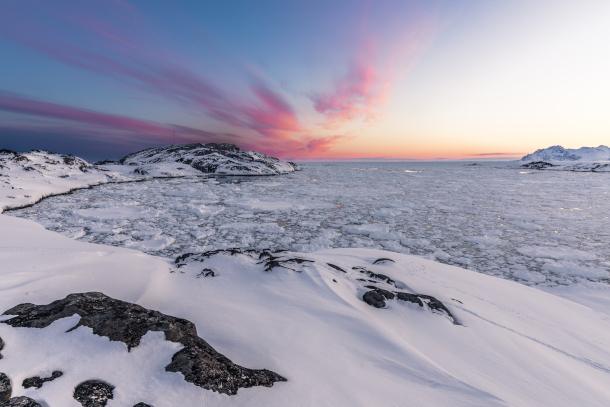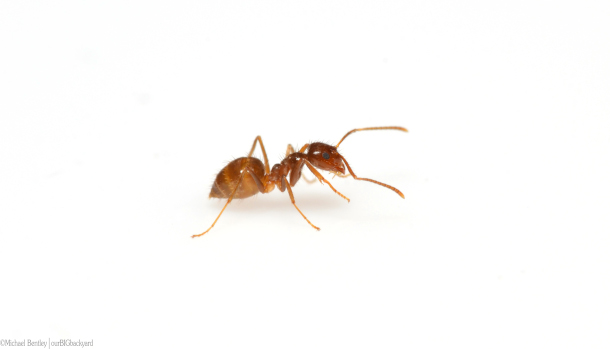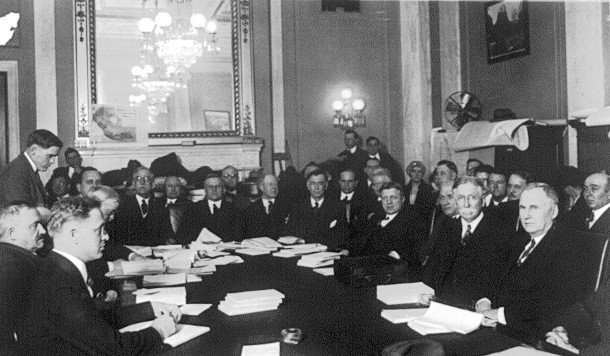Beyond the Headlines
Air Date: Week of April 8, 2022

Portions of permafrost under the Arctic Ocean are melting, just like much permafrost found on land. (Photo: Markus Trienke, Flickr, CC BY_SA 2.0)
On this week's trip beyond the headlines, Host Jenni Doering is joined by Environmental Health News' Weekend Editor Peter Dykstra. First, the two discuss the methane-rich melting permafrost under the Arctic Ocean. Then, they take a look at a killer parasite wiping out an invasive ant species in Texas. And finally, a peek through the history books at the Teapot Dome scandal, 100 years ago.
Transcript
DOERING: It's that time of the broadcast now for a look beyond the headlines with Peter Dykstra. Peter's an editor with Environmental Health News. That's EHN.org and DailyClimate.org. And he joins us from Atlanta, Georgia. Hey, Peter, how you doing this week?
DYKSTRA: Hi, Jenni. I'm doing okay. But we've got a couple of weird, unheard of stories to start us off. First of all, everyone who's followed climate change knows about melting permafrost and how that can release methane, and be kind of a supercharger for climate change in the Arctic. I hadn't known about thawing permafrost from under the Arctic Ocean.
DOERING: Yeah, we've seen these sinkholes in Siberia. But this is actually under the sea floor.
DYKSTRA: That's right. There's a report that came out recently in the Proceedings of the National Academy of Sciences, in which an international team looked at the ocean floor, and saw that off of northern Canada, detected by sonar, are the possible release of large amounts of methane, as the permafrost under the ocean melts just like it does under the land.
DOERING: I guess it's fair to say that what happens up there with the permafrost could really shape the kind of climate warming that we experience.
DYKSTRA: It's fair to say, and it also underscores how little we know about what may be bad, what may be worse, what can be somehow mitigated and what's not so bad. But it's one more thing to think about in an area where we already have plenty to think about.
DOERING: Indeed. Well, I hope that this next story doesn't give us another thing to worry about, Peter.
DYKSTRA: How about a killer parasite? But it's a killer parasite that may end up doing a good thing; that is, going after another killer parasite, in a classic case, of the enemy of our enemy is our friend. And we're talking about an animal, this is it's real name. It's called the tawny crazy ant, native of South America. They've shown up in Texas, and it's beginning to destroy colonies of native ant species. It's also going after other animals like baby birds, some baby reptiles. And what they do is they form super colonies that tend to help each other rather than compete with each other. And they are showing up in Texas at an alarming rate. But so is another parasite that's going after the tawny crazy ants.

Tawny crazy ants are an invasive species in Texas. (Photo: Michael Bentley, Wikimedia Commons, CC BY-SA 4.0)
DOERING: Yeah, I really didn't think that a killer parasite would be good news, Peter, but tell me more.
DYKSTRA: There's a microsporidian fungus-like parasite. It's new, it's a new genus, it's a new species, that scientists are just learning a lot about. It's ruining the day of crazy ants by bloating their bellies, and hopefully lessening their threat to the native species of Texas and elsewhere.
DOERING: Hmm, well, what do you have in the history books this week?
DYKSTRA: Yes, we've got an oil scandal celebrating its 100th birthday. April 7, 1922. A big oil man in the first half of the 20th century named Harry F. Sinclair, acquired exclusive rights to the US Navy's oil holdings at Teapot Dome in Wyoming. It became known as the Teapot Dome Scandal. It was a sweetheart deal with the Interior Secretary Albert Fall. Fall was convicted of related charges. spent a year in jail. Sinclair spent six and a half months in jail for contempt. And it began what's become a long and storied history of oil scandals, starting 100 years ago, this past week.
DOERING: Yeah, you know, I'm glad you bring this up. Because I remember that I was supposed to learn about the Teapot Dome scandal in AP Gov. And I don't think it really stuck with me. So I'm glad for the history lesson, Peter.

Oil businessman Edward L. Doheny (at table, second from right) testifies before the Senate committee investigating the Teapot Dome oil leases. (Photo: National Photo Company Collection, Wikimedia Commons, Public Domain)
DYKSTRA: Well, if it didn't take in your high school US history lessons, fate has guided you to hosting Living on Earth and this segment about Teapot Dome, 100 years after the fact.
DOERING: And here we are. Peter Dykstra is an editor with Environmental Health News. That's EHN.org and DailyClimate.org. And thanks a lot, Peter, as always, we'll talk to you again next week.
DYKSTRA: All right, Jenni. Thanks a lot. Talk to you soon.
DOERING: And there's more on these stories at the Living on Earth website. That's LOE.org.
Links
Undark Magazine | “Under the Sea, a Hidden Climate Variable: Thawing Permafrost”
Wired | “A Killer Parasite Is Wiping Out Hordes of Ants—in a Good Way”
Living on Earth wants to hear from you!
Living on Earth
62 Calef Highway, Suite 212
Lee, NH 03861
Telephone: 617-287-4121
E-mail: comments@loe.org
Newsletter [Click here]
Donate to Living on Earth!
Living on Earth is an independent media program and relies entirely on contributions from listeners and institutions supporting public service. Please donate now to preserve an independent environmental voice.
NewsletterLiving on Earth offers a weekly delivery of the show's rundown to your mailbox. Sign up for our newsletter today!
 Sailors For The Sea: Be the change you want to sea.
Sailors For The Sea: Be the change you want to sea.
 The Grantham Foundation for the Protection of the Environment: Committed to protecting and improving the health of the global environment.
The Grantham Foundation for the Protection of the Environment: Committed to protecting and improving the health of the global environment.
 Contribute to Living on Earth and receive, as our gift to you, an archival print of one of Mark Seth Lender's extraordinary wildlife photographs. Follow the link to see Mark's current collection of photographs.
Contribute to Living on Earth and receive, as our gift to you, an archival print of one of Mark Seth Lender's extraordinary wildlife photographs. Follow the link to see Mark's current collection of photographs.
 Buy a signed copy of Mark Seth Lender's book Smeagull the Seagull & support Living on Earth
Buy a signed copy of Mark Seth Lender's book Smeagull the Seagull & support Living on Earth

